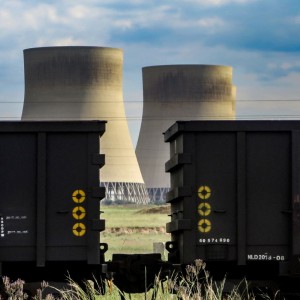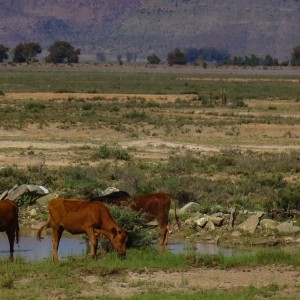
The 4,800-megawatt Kusile coal-fired generating station east of Johannesburg, years overdue and $US billions over budget, is at the center of the damaging economic, social, and ecological vortex engulfing South Africa. Photo © Keith Schneider / Circle of Blue.
By Keith Schneider
Circle of Blue
Though Eskom executives, as well as senior aides at the Department of Energy and Department of Water Affairs, declined to be interviewed for this article, the company’s public statements and government archives describe the confidence and striking national ambition that seasoned the projects. Supported by government-backed guarantees, Eskom raised the first round of financing out of its own reserves, the South African treasury, and a host of African and global financial institutions.
In 2010, the World Bank approved the largest loan ever in its African portfolio — a $US 3.75 billion cash infusion to build Medupi, and to complete a coal transport system and a 100-megawatt wind farm.
The World Bank loan and several other significant loans by global investors, among them the $US 805 million provided by the Export-Import Bank of the United States, encountered resistance in some of South Africa’s financial circles and public interest groups. Critics warned that using rands to pay back loans made in dollars would significantly raise borrowing costs because the rand’s value against the dollar was steadily slipping.
“We warned the government not to take the World Bank loan,” said Bobby Peek, founder and director of groundWork, a respected environmental justice group based in Pietermaritzburg near Durban. “The rand-dollar exchange was trouble. Eskom accused us of scaremongering. They took the loan when the exchange was eight to nine rands per dollar. Now it’s 16. We’re paying twice as much to service that loan.”
Every year since 2010, trouble surrounding the plants has amplified. Chancellor House, the investment arm of the country ruling party, the African National Congress, received $US 6 million in a payment designed to clear the path for Hitachi to win a big contract to supply the plants with boilers. The U.S. Securities and Exchange Commission investigated and Hitachi agreed to pay a $US 19 million fine last year.
And as the year ended, Eskom replaced Medupi’s construction manager and announced that the two plants are not expected to be completed until the early 2020s.
In finance circles outside of South Africa some analysts wonder whether they will ever be fully built. According to an assessment by Profundo Economic Research, a Dutch consultancy, the price tag for both plants has risen to more than $US 32 billion. Eskom, which has been reluctant to publicly release new estimates of the projected costs, has not disputed the Profundo projection. According to the utility’s public documents, construction costs are rising 11 percent a year.
Because so much of South Africa’s treasury is tied to backing the metastasizing debt of the two plants, the nation’s fiscal deficit, and Eskom’s corporate deficit – over $US 22 billion — are expanding while ratings agencies downgrade the corporate credit profile to junk status, and the national credit profile to near junk.
In order to recoup some of the rising costs, Eskom also has petitioned the National Energy Regulator of South Africa, the utility commission, to increase electrical rates. Escalating electricity prices are raking an economy that is employing just two of every three working age adults, and igniting fearful levels of inflation. World markets earlier this year downgraded the value of the rand to around 6 US cents. Economists forecast South Africa could slip into negative growth this year.
So much for the economic trends belting the two plants.
Circle of Blue’s senior editor and chief correspondent based in Traverse City, Michigan. He has reported on the contest for energy, food, and water in the era of climate change from six continents. Contact
Keith Schneider




